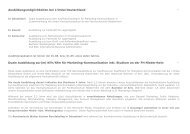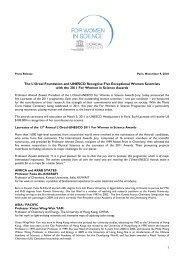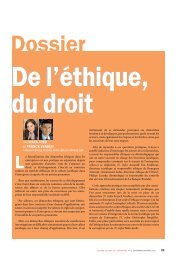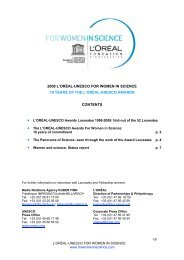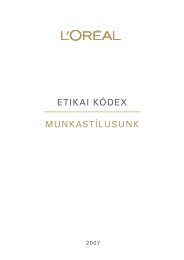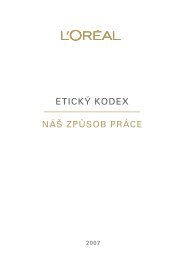CONTENTS - L'Oréal
CONTENTS - L'Oréal
CONTENTS - L'Oréal
You also want an ePaper? Increase the reach of your titles
YUMPU automatically turns print PDFs into web optimized ePapers that Google loves.
L’ORÉAL-UNESCO FOR WOMEN IN SCIENCE 2005<br />
L’ORÉAL-UNESCO AWARDS 2005: The Laureates<br />
major impact on the design of quantum computing<br />
devices. In nano-science Professor Koiller has addressed<br />
the fascinating electromechanical behavior of carbon<br />
nanotubes and optical properties of semiconductor<br />
quantum dots.<br />
Professor Koiller has been a Senior Research Fellow of<br />
the Brazilian National Research Council since 1985. Her<br />
publications have appeared in the most prestigious<br />
physics journals. She was the first woman physicist to be<br />
elected full member to the Brazilian Academy of Sciences<br />
and was decorated Comendador da Ordem Nacional do<br />
Mérito Científico of the Presidency of the Republic of Brazil.<br />
Context of the Laureate’s research<br />
Operating in the micro- and macroscopic<br />
worlds<br />
Belita Koiller’s research is in the line of the long tradition<br />
of studying the properties of crystals and controlling<br />
them. Recent progress has been breathtaking, and has<br />
created the transistorized, digital world in which we live,<br />
with cellular telephones, CDs, DVDs, computers, etc.<br />
The first scientists to take an interest in the geometry of<br />
crystals were Hauy and Bravais at the beginning of the<br />
eighteenth century. They recognized that some solids<br />
exhibited very regular and simple forms that one could<br />
perceive with the naked eye. By looking very closely at a<br />
grain of salt, for example, one can see cubes of different<br />
sizes. Other natural crystals, like quartz, display<br />
hexagonal shapes.<br />
Mineralogists analyzed the crystalline state and found<br />
that every crystal has a definite composition, with the<br />
atoms at specific sites: for example, sodium chloride<br />
(table salt) can be viewed as a cubic array with the<br />
chlorine atoms at the corners of a microscopic cube and<br />
the sodium atom at its center. The great progress they<br />
made was to recognize that the macroscopic shape<br />
reproduces the microscopic arrangement of atoms.<br />
The next step was the recognition that atoms were<br />
composed of a positively charged nucleus surrounded by<br />
negatively charged electrons. The heavy nuclei were at the<br />
sites characterizing the crystal while the electrons were<br />
in some cases allowed to move. When they are able to<br />
move, the crystal is a conductor. When the electrons do<br />
not conduct electricity, the material is an insulator. If the<br />
electrons are such that the crystal is a conductor, a<br />
voltage applied across two opposite surfaces of the<br />
crystal induces a flow of electrons, and thus a current.<br />
The microscopic basis of the delicate behavior of<br />
electrons in solids was elucidated by the quantum<br />
physicists in the period between 1930 and 1950.<br />
The semiconductors of the modern world<br />
A semiconductor is a crystal in which some impurities<br />
(dopants) have been introduced to control the conductivity.<br />
Thus semiconductors (poor conductors and poor<br />
insulators) became important when artificial doping<br />
became available: the conductivity and even the (positive<br />
or negative) sign of the current carriers in<br />
semiconductors could be controlled by doping. In 1947,<br />
the transistor - a semiconductor crystal with different



